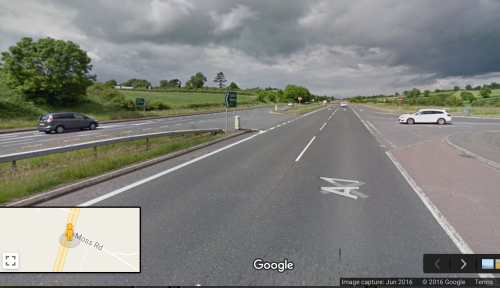Ten years ago, on 21 November 2006, Roads Service opened a new stretch of dual-carriageway, on the A1 between Loughbrickland and Beech Hill, just north of Newry. We in Northern Ireland have built quite a number of dual-carriageways over the past ten years, but one important point sets this one apart from the others.
It was the last at-grade dual-carriageway built on the strategic road network in Northern Ireland. The phrase “at-grade” means that the road has T-junctions with gaps in the central reservation where vehicles can turn right across the opposite carriageway. Like this one:

The opposite of “at-grade” is “grade-separated”, which means that junctions are comprised of flyovers with either sliproads, or left-turn-only T-junctions, such that vehicles cannot cross the central barrier. Like this one:

We built at-grade dual-carriageways in Northern Ireland from 1959, when the Sydenham Bypass opened, right up until 2006 when the A1 from Loughbrickland to Beech Hill opened. And after that, we stopped. Today we only built “high quality” dual-carriageways, called HQDCs for short. HQDCs do not have gaps* in the central reservation. (Though they do sometimes have roundabouts. Roundabouts are annoying for drivers, but far less dangerous than turning right across the central reservation.)
Why have we phased out at-grade dual-carriageways? Because they are lethal. Allowing right turns on a dual-carriageway may have been fine in the 1960s with much lower traffic levels and at a time when many vehicles travelled at 40mph, but today most vehicles travel at 70mph and there are thousands of them. Take these speeds and add a bit of rain or mist, twilight and lots of glaring headlights and it’s not difficult to see why people die at these “gap junctions” again and again and again.
By contrast, HQDCs are much safer. For example, the A4 between Dungannon and Ballygawley was upgraded to HQDC standard in 2010. In the six years prior to the upgrade, 2004-2009, 10 people died on that stretch. By contrast, in the past five years, 2012-2016, only 3 people have died on the new dual-carriageway. That’s a reduction of over 50%. So there are at least 5 people alive today who would have been dead had it not been for the A4 dualling scheme.
At-grade dual-carriageways are now out-dated and dangerous relics of the 20th century. That’s why it’s a very good thing that the A1 from Loughbrickland to Beech Hill was the last such road built here. It’s just a shame that it took until 2006 for us to reach this conclusion.
Today there are two stretches of at-grade dual-carriageway in Northern Ireland that stand out as particularly lethal, and both need dealt with urgently:
- The A1 from Sprucefield to Beech Hill. TransportNI currently has plans to upgrade the A1 from Sprucefield to Loughbrickland to HQDC standard, but there are still no plans to do the same on the Loughbrickland to Beech Hill stretch.
- The A26 from Antrim to Ballymena, which is likewise claiming life after life at these notorious gap junctions. Limited alterations to the junctions are now planned here but there are no plans for a more general upgrade of the stretch.
It is time for TransportNI to put upgrades to both these stretches into the forward planning programme and stop the “gap junction” carnage.
*Purists may remind me that there is one gap on the A26 Ballee Road East south of Ballymena which opened after 2006. I am content to strike this off as a special case since the road was an upgrade of a 1960s dual-carriageway, and not a new road at this point.
Leave a comment